SUSS Psychology: Stroop Effect Experiment Report Analysis
VerifiedAdded on 2021/04/24
|12
|1640
|26
Report
AI Summary
This report details an experiment designed to investigate the Stroop Effect, a psychological phenomenon demonstrating interference in the reaction time of a task. The experiment involved 20 participants, randomly assigned to either a congruent or incongruent task group. The congruent group was presented with color squares, while the incongruent group saw color names printed in different ink colors. The study hypothesized that participants would be faster in the congruent task. Results showed a significant difference in reaction times, with participants in the incongruent group taking longer to name the colors. The findings support the Stroop Effect, confirming that the automatic process of reading interferes with color naming when the color name and ink color are mismatched. The report includes the experimental design, materials, procedure, results, and a discussion of the findings, referencing relevant literature and providing a consent form and instructions used in the experiment.
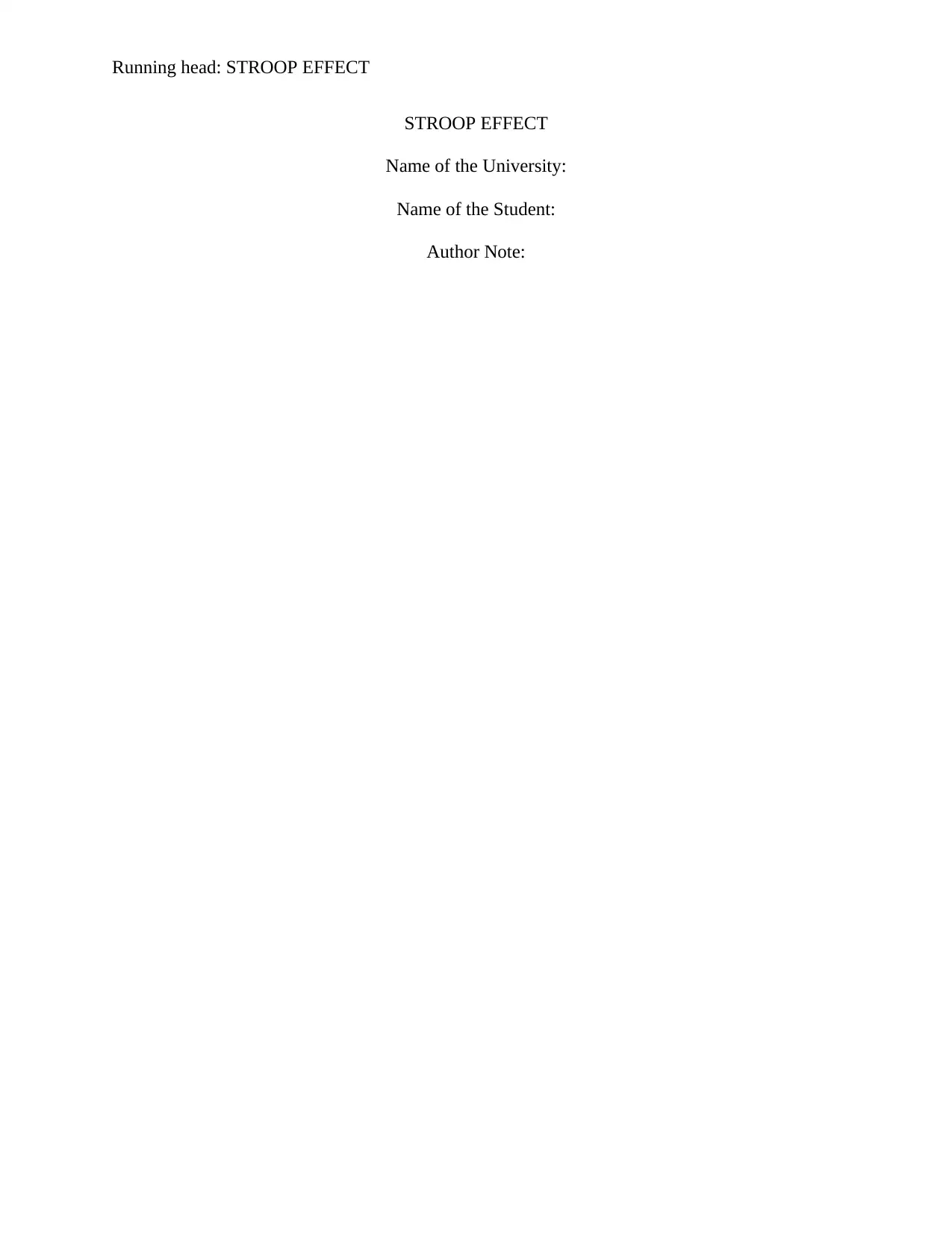
Running head: STROOP EFFECT
STROOP EFFECT
Name of the University:
Name of the Student:
Author Note:
STROOP EFFECT
Name of the University:
Name of the Student:
Author Note:
Paraphrase This Document
Need a fresh take? Get an instant paraphrase of this document with our AI Paraphraser
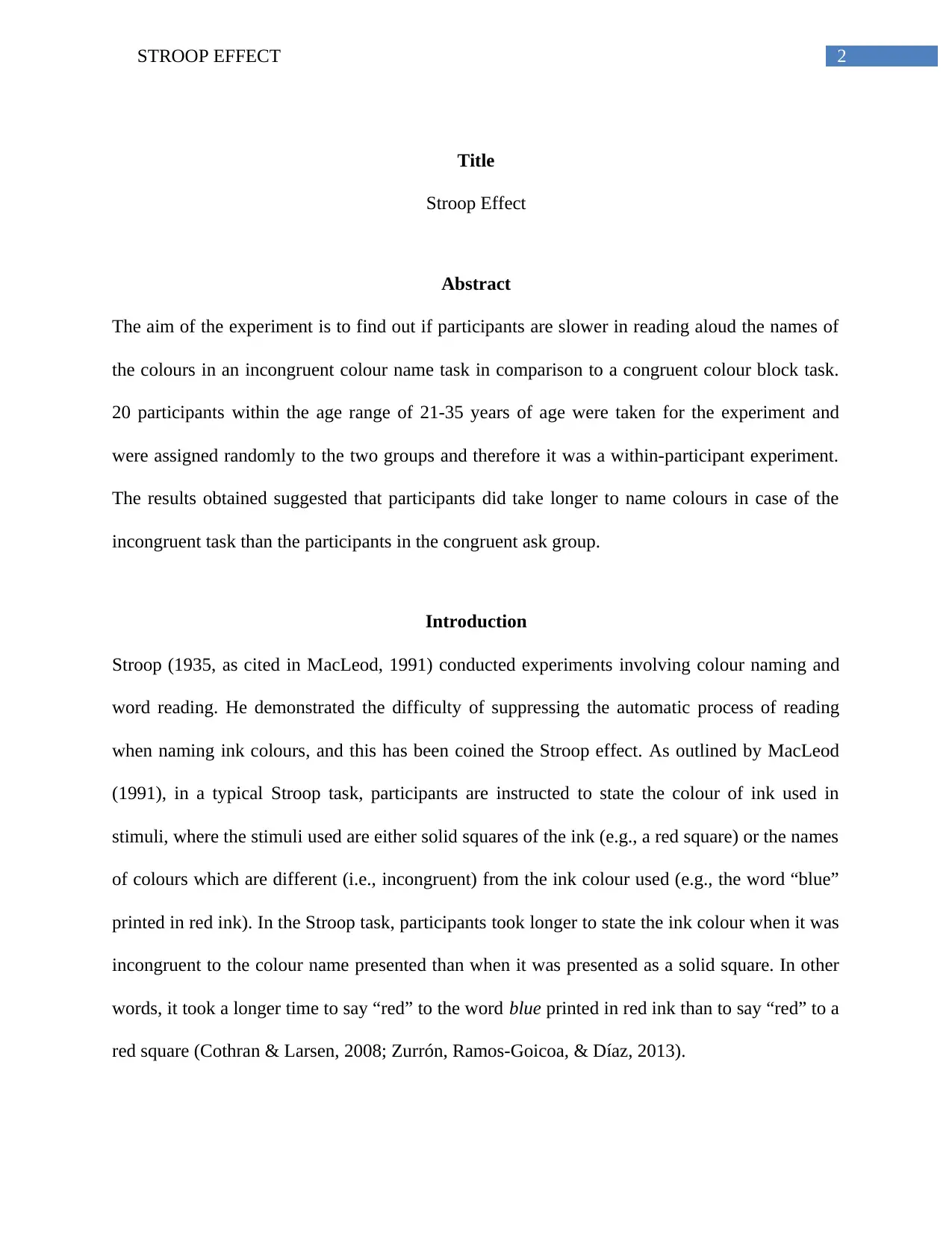
2STROOP EFFECT
Title
Stroop Effect
Abstract
The aim of the experiment is to find out if participants are slower in reading aloud the names of
the colours in an incongruent colour name task in comparison to a congruent colour block task.
20 participants within the age range of 21-35 years of age were taken for the experiment and
were assigned randomly to the two groups and therefore it was a within-participant experiment.
The results obtained suggested that participants did take longer to name colours in case of the
incongruent task than the participants in the congruent ask group.
Introduction
Stroop (1935, as cited in MacLeod, 1991) conducted experiments involving colour naming and
word reading. He demonstrated the difficulty of suppressing the automatic process of reading
when naming ink colours, and this has been coined the Stroop effect. As outlined by MacLeod
(1991), in a typical Stroop task, participants are instructed to state the colour of ink used in
stimuli, where the stimuli used are either solid squares of the ink (e.g., a red square) or the names
of colours which are different (i.e., incongruent) from the ink colour used (e.g., the word “blue”
printed in red ink). In the Stroop task, participants took longer to state the ink colour when it was
incongruent to the colour name presented than when it was presented as a solid square. In other
words, it took a longer time to say “red” to the word blue printed in red ink than to say “red” to a
red square (Cothran & Larsen, 2008; Zurrón, Ramos-Goicoa, & Díaz, 2013).
Title
Stroop Effect
Abstract
The aim of the experiment is to find out if participants are slower in reading aloud the names of
the colours in an incongruent colour name task in comparison to a congruent colour block task.
20 participants within the age range of 21-35 years of age were taken for the experiment and
were assigned randomly to the two groups and therefore it was a within-participant experiment.
The results obtained suggested that participants did take longer to name colours in case of the
incongruent task than the participants in the congruent ask group.
Introduction
Stroop (1935, as cited in MacLeod, 1991) conducted experiments involving colour naming and
word reading. He demonstrated the difficulty of suppressing the automatic process of reading
when naming ink colours, and this has been coined the Stroop effect. As outlined by MacLeod
(1991), in a typical Stroop task, participants are instructed to state the colour of ink used in
stimuli, where the stimuli used are either solid squares of the ink (e.g., a red square) or the names
of colours which are different (i.e., incongruent) from the ink colour used (e.g., the word “blue”
printed in red ink). In the Stroop task, participants took longer to state the ink colour when it was
incongruent to the colour name presented than when it was presented as a solid square. In other
words, it took a longer time to say “red” to the word blue printed in red ink than to say “red” to a
red square (Cothran & Larsen, 2008; Zurrón, Ramos-Goicoa, & Díaz, 2013).
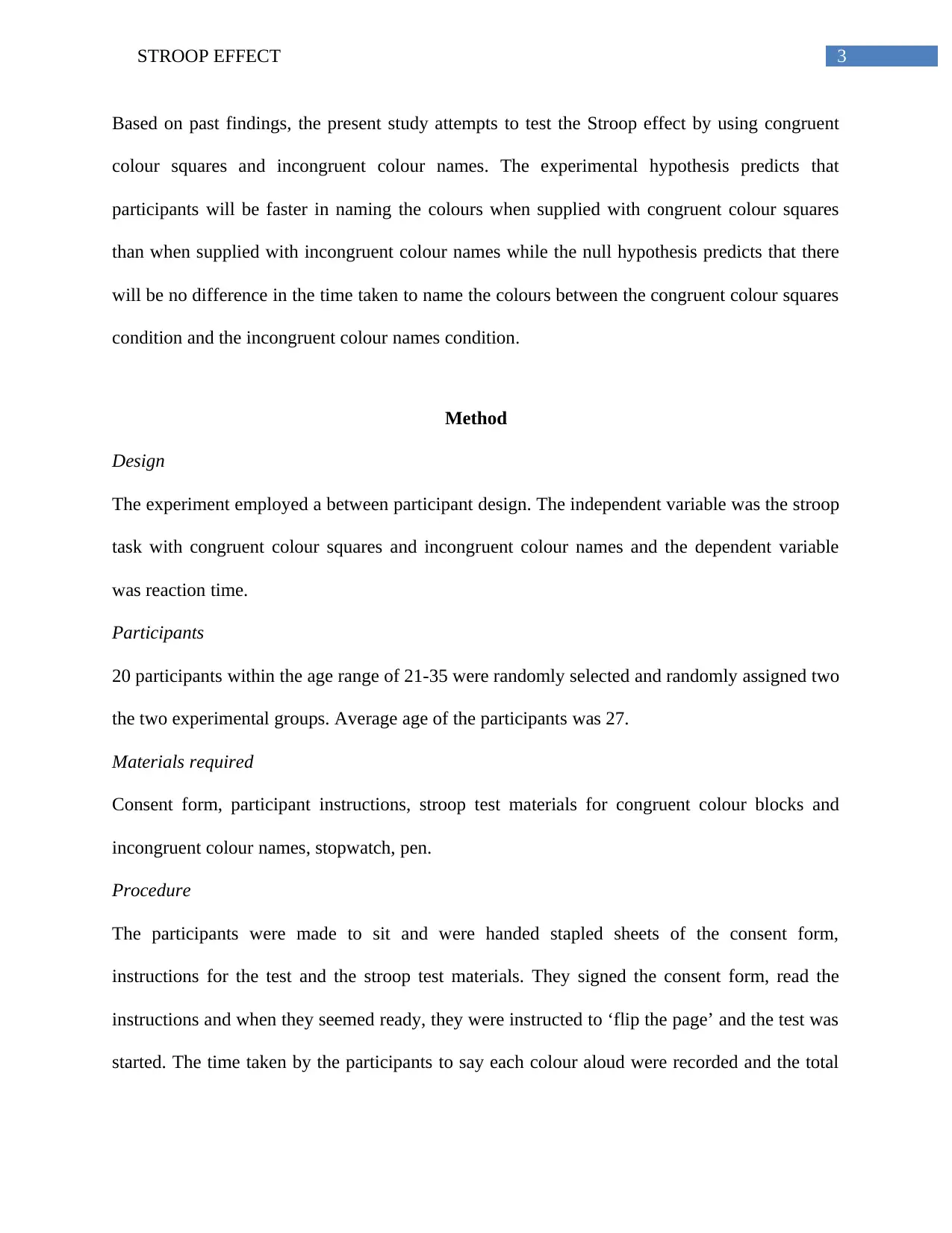
3STROOP EFFECT
Based on past findings, the present study attempts to test the Stroop effect by using congruent
colour squares and incongruent colour names. The experimental hypothesis predicts that
participants will be faster in naming the colours when supplied with congruent colour squares
than when supplied with incongruent colour names while the null hypothesis predicts that there
will be no difference in the time taken to name the colours between the congruent colour squares
condition and the incongruent colour names condition.
Method
Design
The experiment employed a between participant design. The independent variable was the stroop
task with congruent colour squares and incongruent colour names and the dependent variable
was reaction time.
Participants
20 participants within the age range of 21-35 were randomly selected and randomly assigned two
the two experimental groups. Average age of the participants was 27.
Materials required
Consent form, participant instructions, stroop test materials for congruent colour blocks and
incongruent colour names, stopwatch, pen.
Procedure
The participants were made to sit and were handed stapled sheets of the consent form,
instructions for the test and the stroop test materials. They signed the consent form, read the
instructions and when they seemed ready, they were instructed to ‘flip the page’ and the test was
started. The time taken by the participants to say each colour aloud were recorded and the total
Based on past findings, the present study attempts to test the Stroop effect by using congruent
colour squares and incongruent colour names. The experimental hypothesis predicts that
participants will be faster in naming the colours when supplied with congruent colour squares
than when supplied with incongruent colour names while the null hypothesis predicts that there
will be no difference in the time taken to name the colours between the congruent colour squares
condition and the incongruent colour names condition.
Method
Design
The experiment employed a between participant design. The independent variable was the stroop
task with congruent colour squares and incongruent colour names and the dependent variable
was reaction time.
Participants
20 participants within the age range of 21-35 were randomly selected and randomly assigned two
the two experimental groups. Average age of the participants was 27.
Materials required
Consent form, participant instructions, stroop test materials for congruent colour blocks and
incongruent colour names, stopwatch, pen.
Procedure
The participants were made to sit and were handed stapled sheets of the consent form,
instructions for the test and the stroop test materials. They signed the consent form, read the
instructions and when they seemed ready, they were instructed to ‘flip the page’ and the test was
started. The time taken by the participants to say each colour aloud were recorded and the total
⊘ This is a preview!⊘
Do you want full access?
Subscribe today to unlock all pages.

Trusted by 1+ million students worldwide
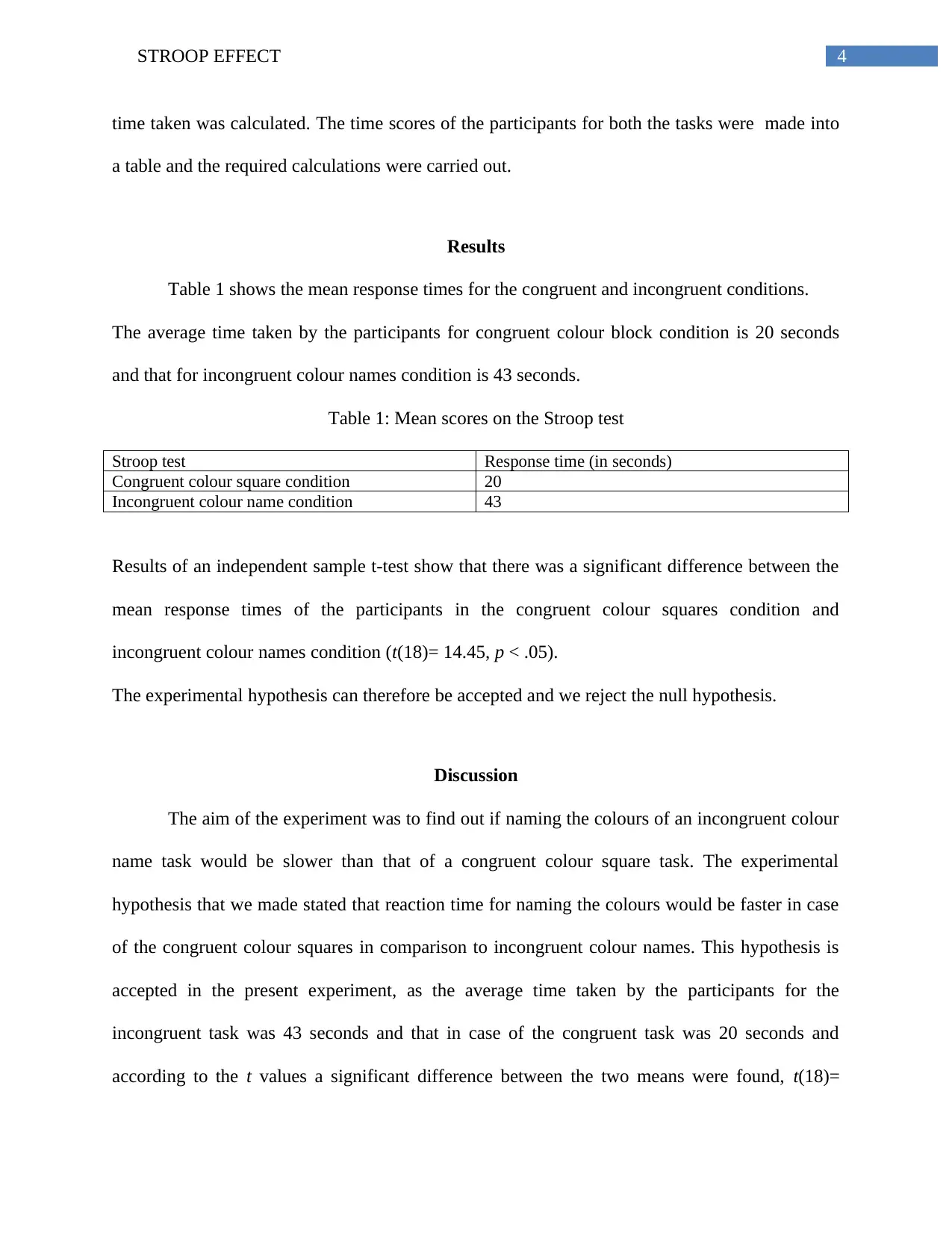
4STROOP EFFECT
time taken was calculated. The time scores of the participants for both the tasks were made into
a table and the required calculations were carried out.
Results
Table 1 shows the mean response times for the congruent and incongruent conditions.
The average time taken by the participants for congruent colour block condition is 20 seconds
and that for incongruent colour names condition is 43 seconds.
Table 1: Mean scores on the Stroop test
Stroop test Response time (in seconds)
Congruent colour square condition 20
Incongruent colour name condition 43
Results of an independent sample t-test show that there was a significant difference between the
mean response times of the participants in the congruent colour squares condition and
incongruent colour names condition (t(18)= 14.45, p < .05).
The experimental hypothesis can therefore be accepted and we reject the null hypothesis.
Discussion
The aim of the experiment was to find out if naming the colours of an incongruent colour
name task would be slower than that of a congruent colour square task. The experimental
hypothesis that we made stated that reaction time for naming the colours would be faster in case
of the congruent colour squares in comparison to incongruent colour names. This hypothesis is
accepted in the present experiment, as the average time taken by the participants for the
incongruent task was 43 seconds and that in case of the congruent task was 20 seconds and
according to the t values a significant difference between the two means were found, t(18)=
time taken was calculated. The time scores of the participants for both the tasks were made into
a table and the required calculations were carried out.
Results
Table 1 shows the mean response times for the congruent and incongruent conditions.
The average time taken by the participants for congruent colour block condition is 20 seconds
and that for incongruent colour names condition is 43 seconds.
Table 1: Mean scores on the Stroop test
Stroop test Response time (in seconds)
Congruent colour square condition 20
Incongruent colour name condition 43
Results of an independent sample t-test show that there was a significant difference between the
mean response times of the participants in the congruent colour squares condition and
incongruent colour names condition (t(18)= 14.45, p < .05).
The experimental hypothesis can therefore be accepted and we reject the null hypothesis.
Discussion
The aim of the experiment was to find out if naming the colours of an incongruent colour
name task would be slower than that of a congruent colour square task. The experimental
hypothesis that we made stated that reaction time for naming the colours would be faster in case
of the congruent colour squares in comparison to incongruent colour names. This hypothesis is
accepted in the present experiment, as the average time taken by the participants for the
incongruent task was 43 seconds and that in case of the congruent task was 20 seconds and
according to the t values a significant difference between the two means were found, t(18)=
Paraphrase This Document
Need a fresh take? Get an instant paraphrase of this document with our AI Paraphraser
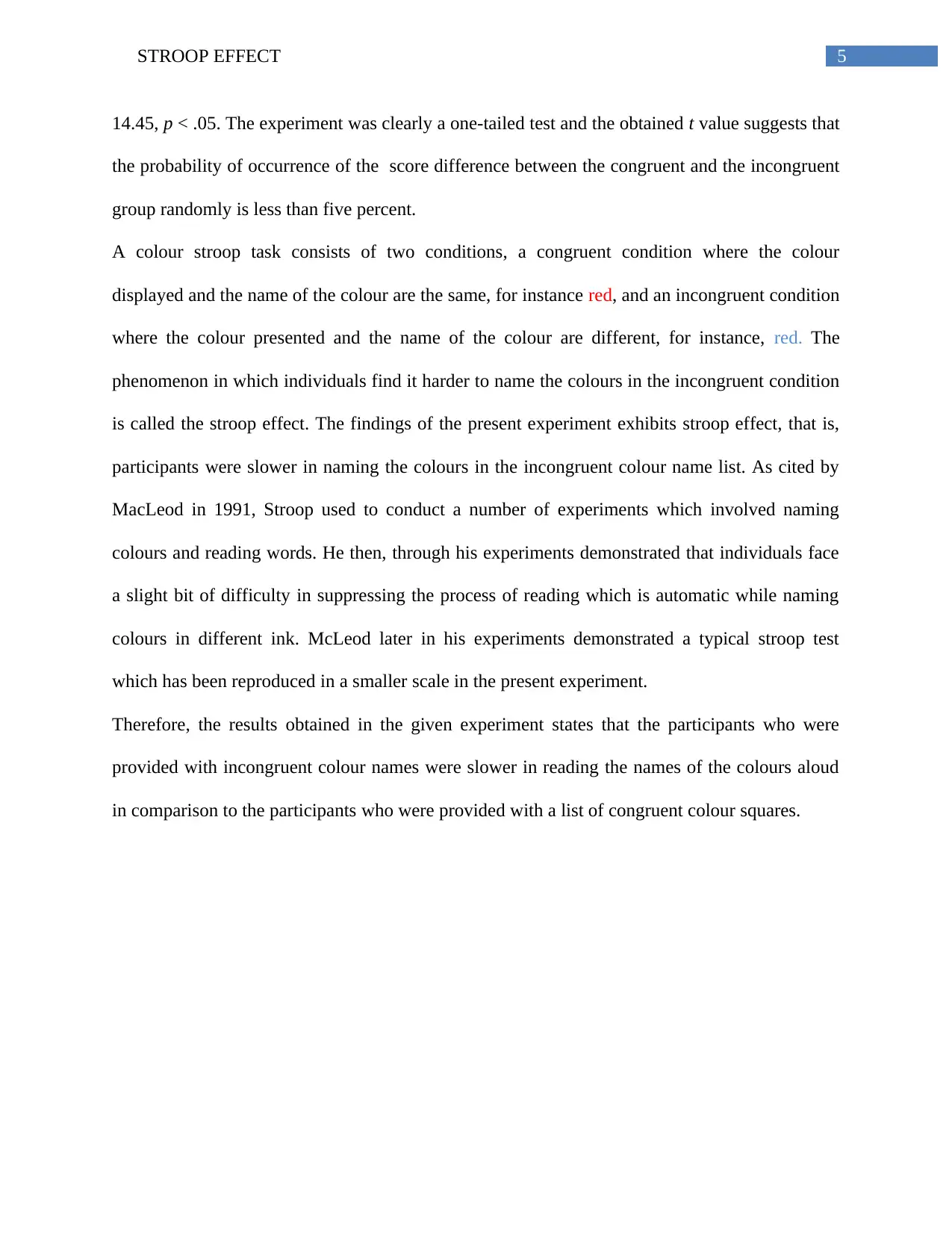
5STROOP EFFECT
14.45, p < .05. The experiment was clearly a one-tailed test and the obtained t value suggests that
the probability of occurrence of the score difference between the congruent and the incongruent
group randomly is less than five percent.
A colour stroop task consists of two conditions, a congruent condition where the colour
displayed and the name of the colour are the same, for instance red, and an incongruent condition
where the colour presented and the name of the colour are different, for instance, red. The
phenomenon in which individuals find it harder to name the colours in the incongruent condition
is called the stroop effect. The findings of the present experiment exhibits stroop effect, that is,
participants were slower in naming the colours in the incongruent colour name list. As cited by
MacLeod in 1991, Stroop used to conduct a number of experiments which involved naming
colours and reading words. He then, through his experiments demonstrated that individuals face
a slight bit of difficulty in suppressing the process of reading which is automatic while naming
colours in different ink. McLeod later in his experiments demonstrated a typical stroop test
which has been reproduced in a smaller scale in the present experiment.
Therefore, the results obtained in the given experiment states that the participants who were
provided with incongruent colour names were slower in reading the names of the colours aloud
in comparison to the participants who were provided with a list of congruent colour squares.
14.45, p < .05. The experiment was clearly a one-tailed test and the obtained t value suggests that
the probability of occurrence of the score difference between the congruent and the incongruent
group randomly is less than five percent.
A colour stroop task consists of two conditions, a congruent condition where the colour
displayed and the name of the colour are the same, for instance red, and an incongruent condition
where the colour presented and the name of the colour are different, for instance, red. The
phenomenon in which individuals find it harder to name the colours in the incongruent condition
is called the stroop effect. The findings of the present experiment exhibits stroop effect, that is,
participants were slower in naming the colours in the incongruent colour name list. As cited by
MacLeod in 1991, Stroop used to conduct a number of experiments which involved naming
colours and reading words. He then, through his experiments demonstrated that individuals face
a slight bit of difficulty in suppressing the process of reading which is automatic while naming
colours in different ink. McLeod later in his experiments demonstrated a typical stroop test
which has been reproduced in a smaller scale in the present experiment.
Therefore, the results obtained in the given experiment states that the participants who were
provided with incongruent colour names were slower in reading the names of the colours aloud
in comparison to the participants who were provided with a list of congruent colour squares.
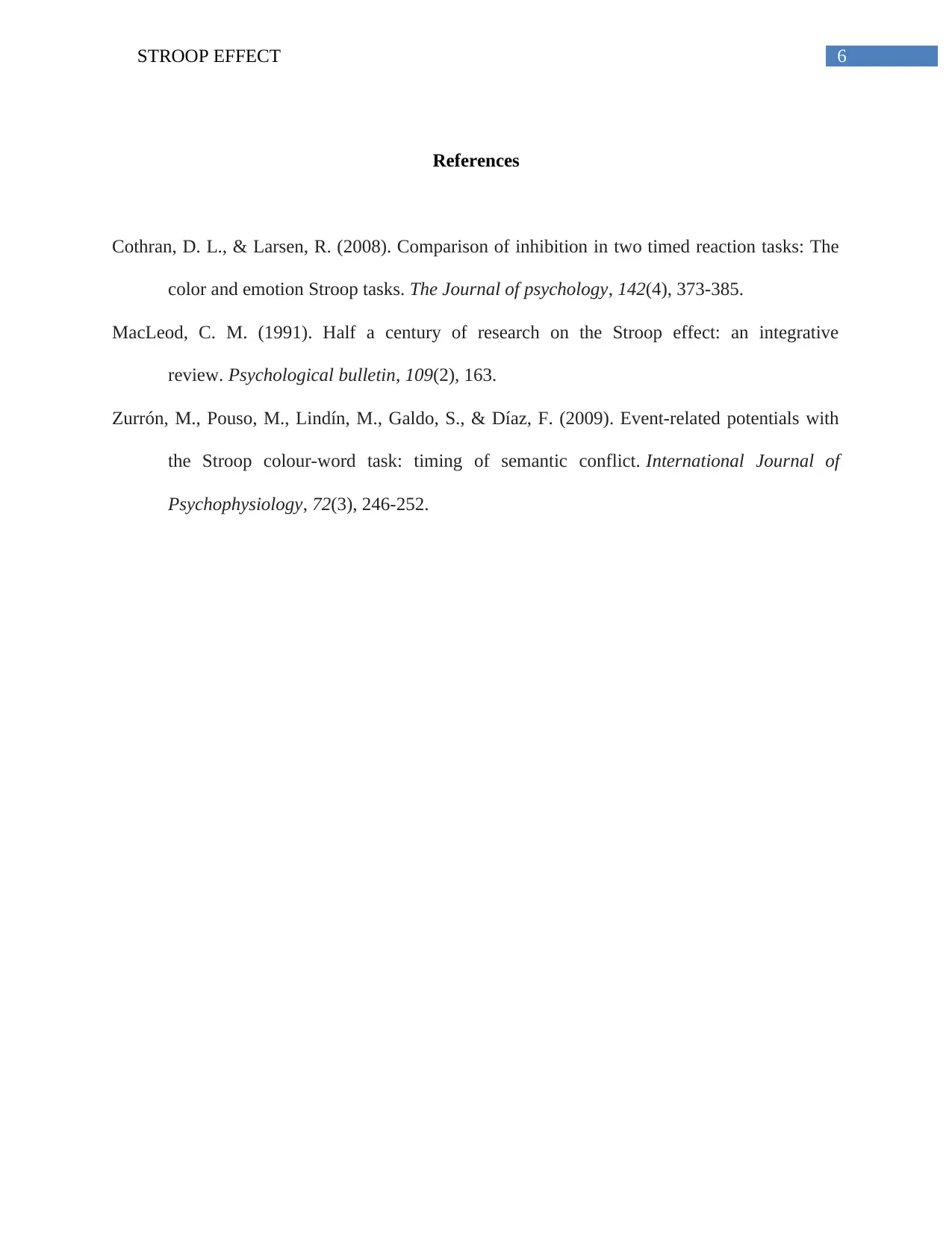
6STROOP EFFECT
References
Cothran, D. L., & Larsen, R. (2008). Comparison of inhibition in two timed reaction tasks: The
color and emotion Stroop tasks. The Journal of psychology, 142(4), 373-385.
MacLeod, C. M. (1991). Half a century of research on the Stroop effect: an integrative
review. Psychological bulletin, 109(2), 163.
Zurrón, M., Pouso, M., Lindín, M., Galdo, S., & Díaz, F. (2009). Event-related potentials with
the Stroop colour-word task: timing of semantic conflict. International Journal of
Psychophysiology, 72(3), 246-252.
References
Cothran, D. L., & Larsen, R. (2008). Comparison of inhibition in two timed reaction tasks: The
color and emotion Stroop tasks. The Journal of psychology, 142(4), 373-385.
MacLeod, C. M. (1991). Half a century of research on the Stroop effect: an integrative
review. Psychological bulletin, 109(2), 163.
Zurrón, M., Pouso, M., Lindín, M., Galdo, S., & Díaz, F. (2009). Event-related potentials with
the Stroop colour-word task: timing of semantic conflict. International Journal of
Psychophysiology, 72(3), 246-252.
⊘ This is a preview!⊘
Do you want full access?
Subscribe today to unlock all pages.

Trusted by 1+ million students worldwide
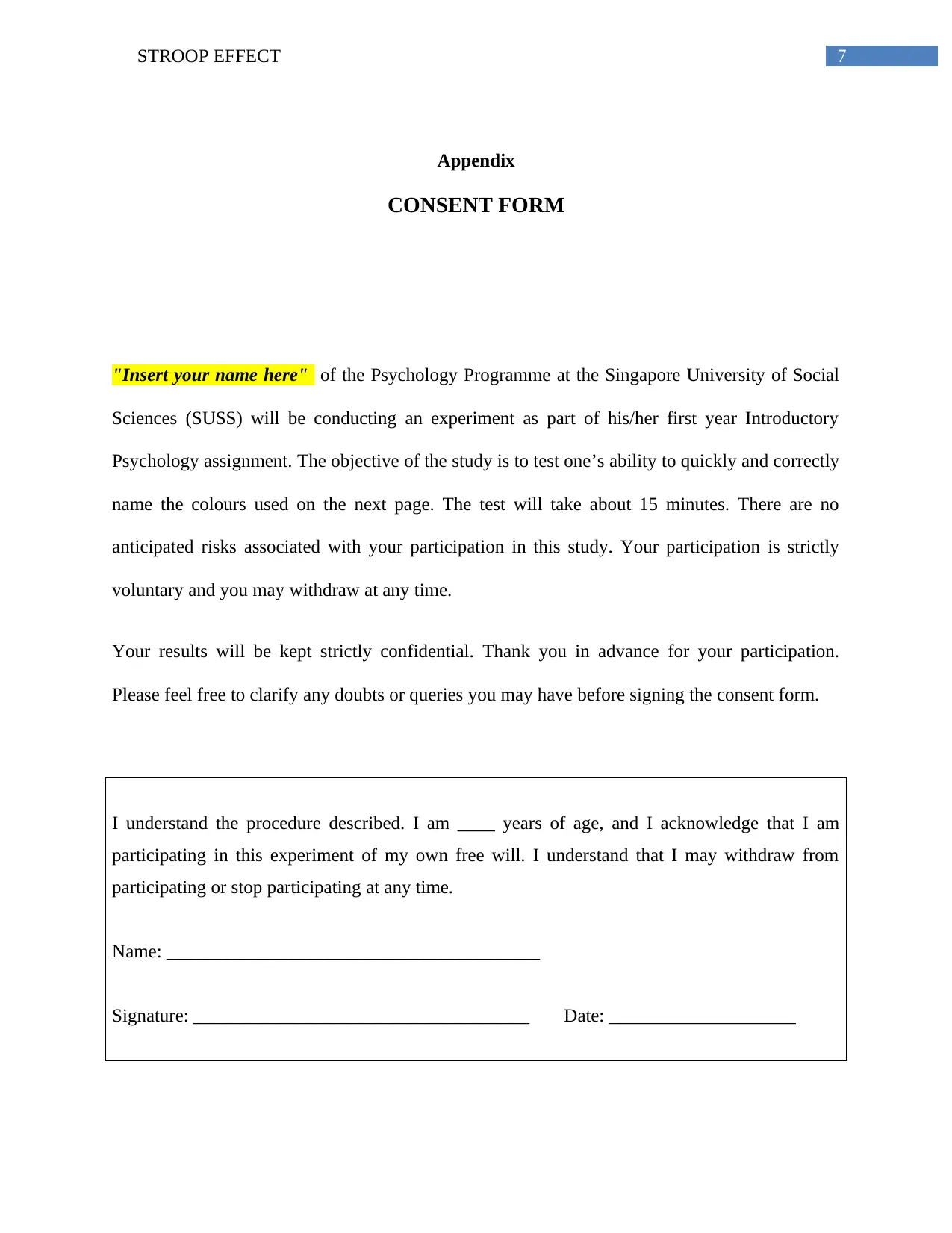
7STROOP EFFECT
Appendix
CONSENT FORM
"Insert your name here" of the Psychology Programme at the Singapore University of Social
Sciences (SUSS) will be conducting an experiment as part of his/her first year Introductory
Psychology assignment. The objective of the study is to test one’s ability to quickly and correctly
name the colours used on the next page. The test will take about 15 minutes. There are no
anticipated risks associated with your participation in this study. Your participation is strictly
voluntary and you may withdraw at any time.
Your results will be kept strictly confidential. Thank you in advance for your participation.
Please feel free to clarify any doubts or queries you may have before signing the consent form.
I understand the procedure described. I am ____ years of age, and I acknowledge that I am
participating in this experiment of my own free will. I understand that I may withdraw from
participating or stop participating at any time.
Name: ________________________________________
Signature: ____________________________________ Date: ____________________
Appendix
CONSENT FORM
"Insert your name here" of the Psychology Programme at the Singapore University of Social
Sciences (SUSS) will be conducting an experiment as part of his/her first year Introductory
Psychology assignment. The objective of the study is to test one’s ability to quickly and correctly
name the colours used on the next page. The test will take about 15 minutes. There are no
anticipated risks associated with your participation in this study. Your participation is strictly
voluntary and you may withdraw at any time.
Your results will be kept strictly confidential. Thank you in advance for your participation.
Please feel free to clarify any doubts or queries you may have before signing the consent form.
I understand the procedure described. I am ____ years of age, and I acknowledge that I am
participating in this experiment of my own free will. I understand that I may withdraw from
participating or stop participating at any time.
Name: ________________________________________
Signature: ____________________________________ Date: ____________________
Paraphrase This Document
Need a fresh take? Get an instant paraphrase of this document with our AI Paraphraser
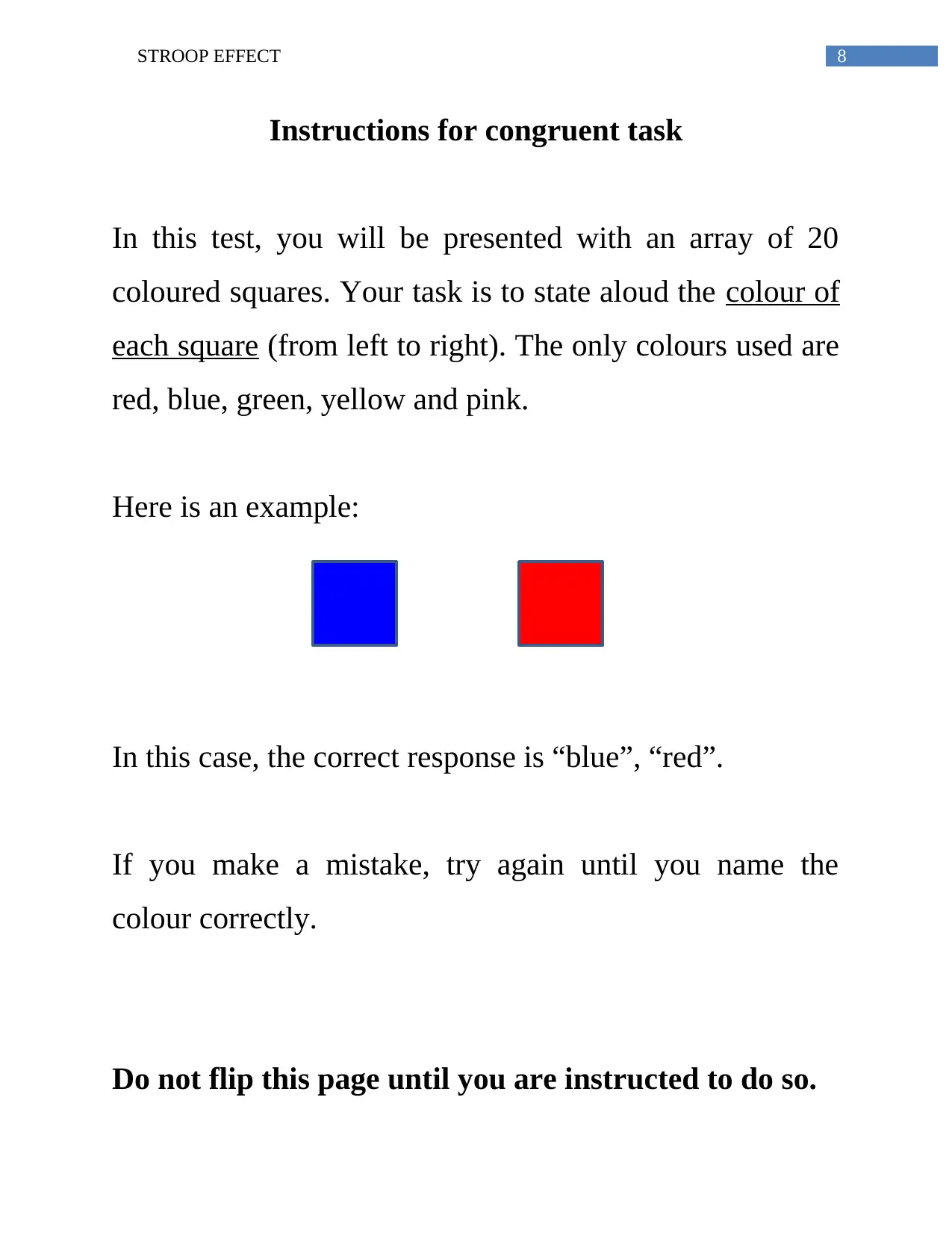
8STROOP EFFECT
Instructions for congruent task
In this test, you will be presented with an array of 20
coloured squares. Your task is to state aloud the colour of
each square (from left to right). The only colours used are
red, blue, green, yellow and pink.
Here is an example:
In this case, the correct response is “blue”, “red”.
If you make a mistake, try again until you name the
colour correctly.
Do not flip this page until you are instructed to do so.
Instructions for congruent task
In this test, you will be presented with an array of 20
coloured squares. Your task is to state aloud the colour of
each square (from left to right). The only colours used are
red, blue, green, yellow and pink.
Here is an example:
In this case, the correct response is “blue”, “red”.
If you make a mistake, try again until you name the
colour correctly.
Do not flip this page until you are instructed to do so.
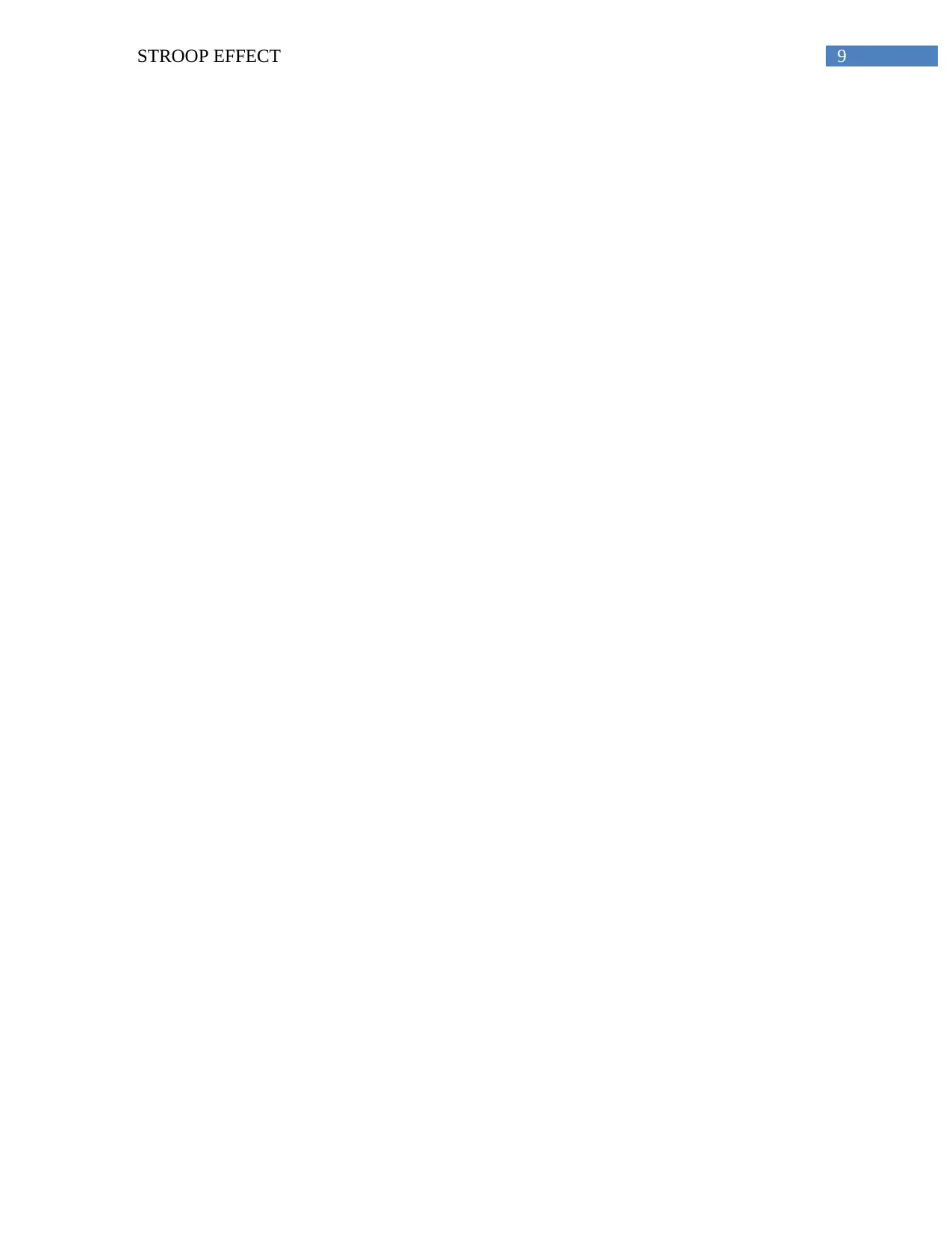
9STROOP EFFECT
⊘ This is a preview!⊘
Do you want full access?
Subscribe today to unlock all pages.

Trusted by 1+ million students worldwide
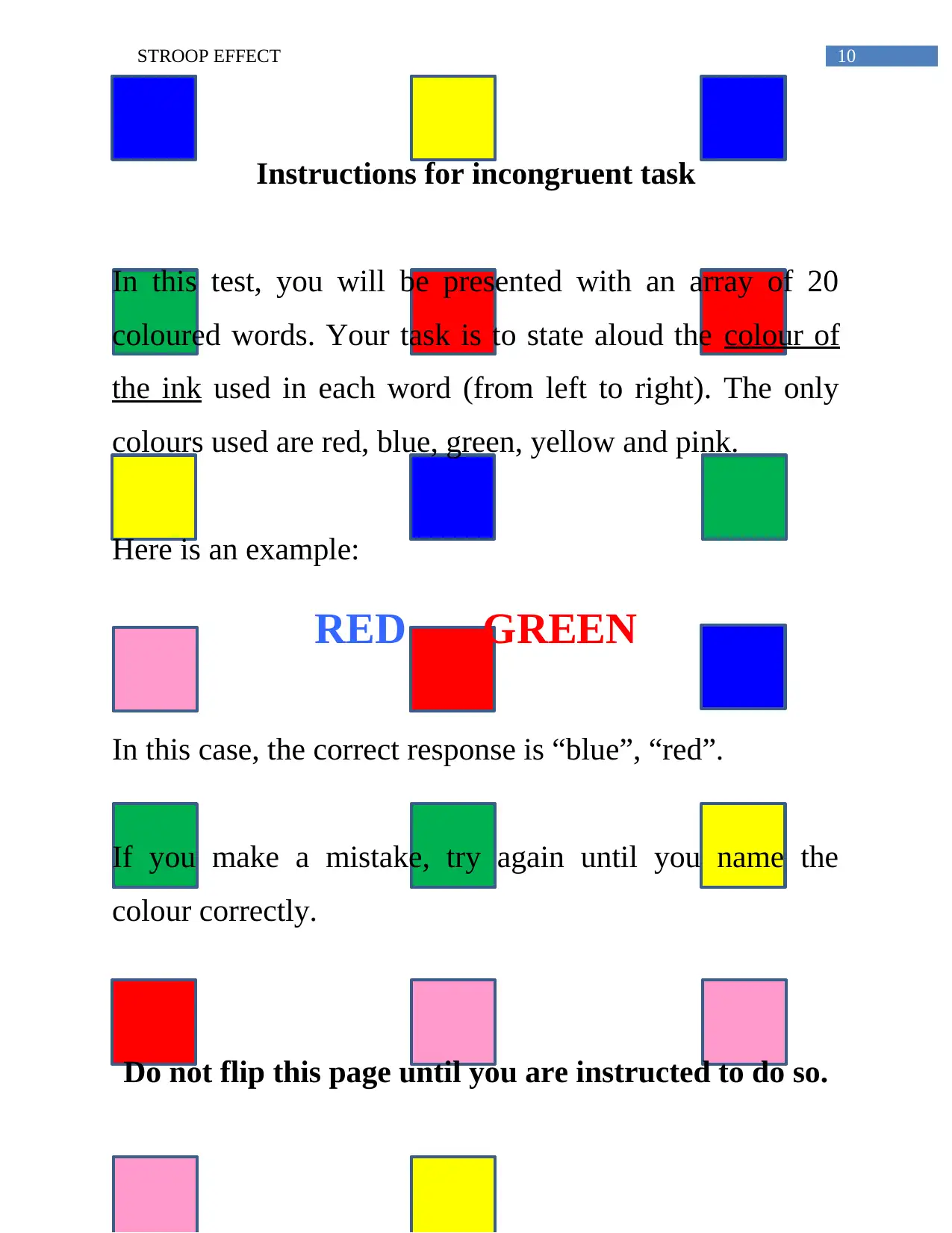
10STROOP EFFECT
Instructions for incongruent task
In this test, you will be presented with an array of 20
coloured words. Your task is to state aloud the colour of
the ink used in each word (from left to right). The only
colours used are red, blue, green, yellow and pink.
Here is an example:
RED GREEN
In this case, the correct response is “blue”, “red”.
If you make a mistake, try again until you name the
colour correctly.
Do not flip this page until you are instructed to do so.
Instructions for incongruent task
In this test, you will be presented with an array of 20
coloured words. Your task is to state aloud the colour of
the ink used in each word (from left to right). The only
colours used are red, blue, green, yellow and pink.
Here is an example:
RED GREEN
In this case, the correct response is “blue”, “red”.
If you make a mistake, try again until you name the
colour correctly.
Do not flip this page until you are instructed to do so.
Paraphrase This Document
Need a fresh take? Get an instant paraphrase of this document with our AI Paraphraser
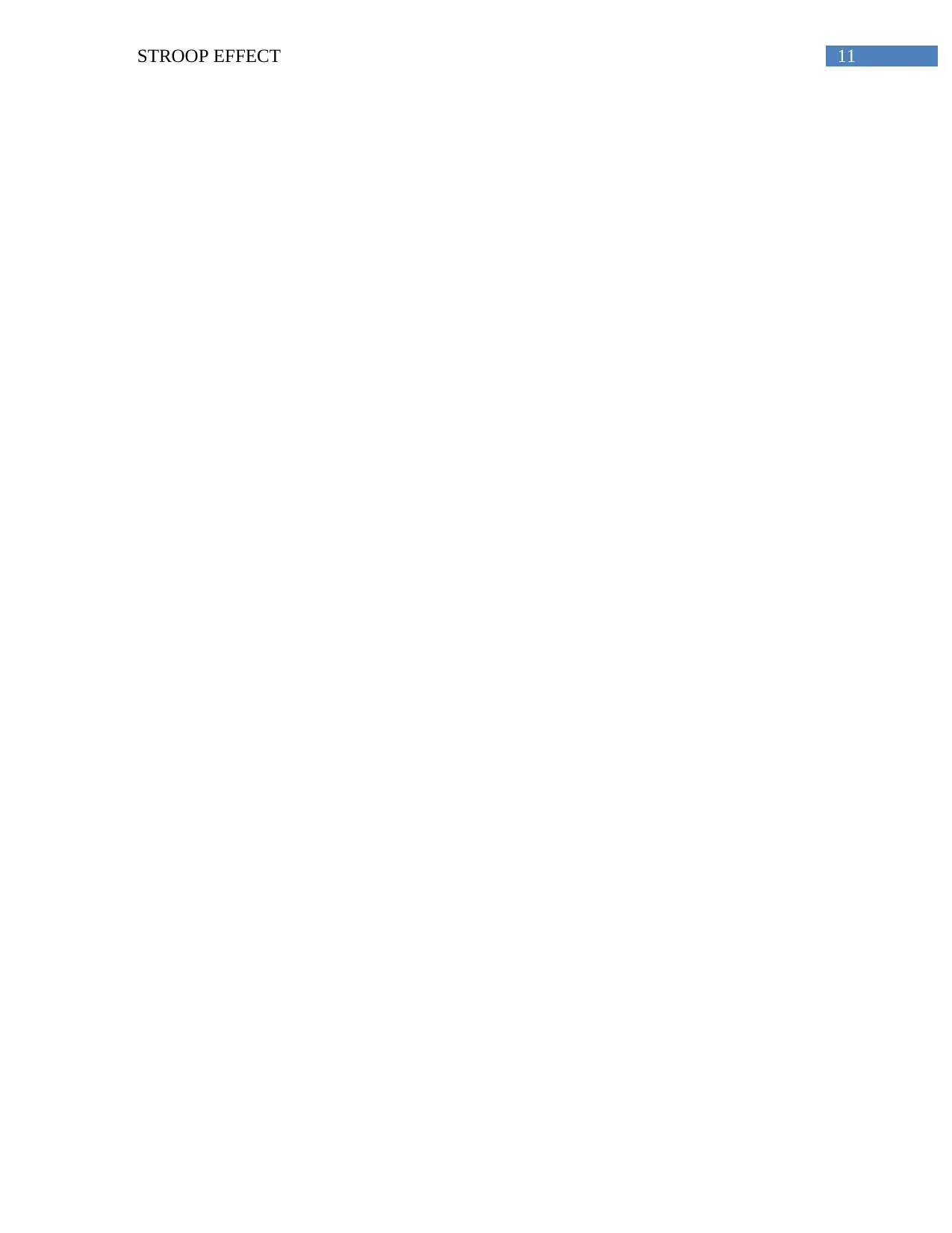
11STROOP EFFECT
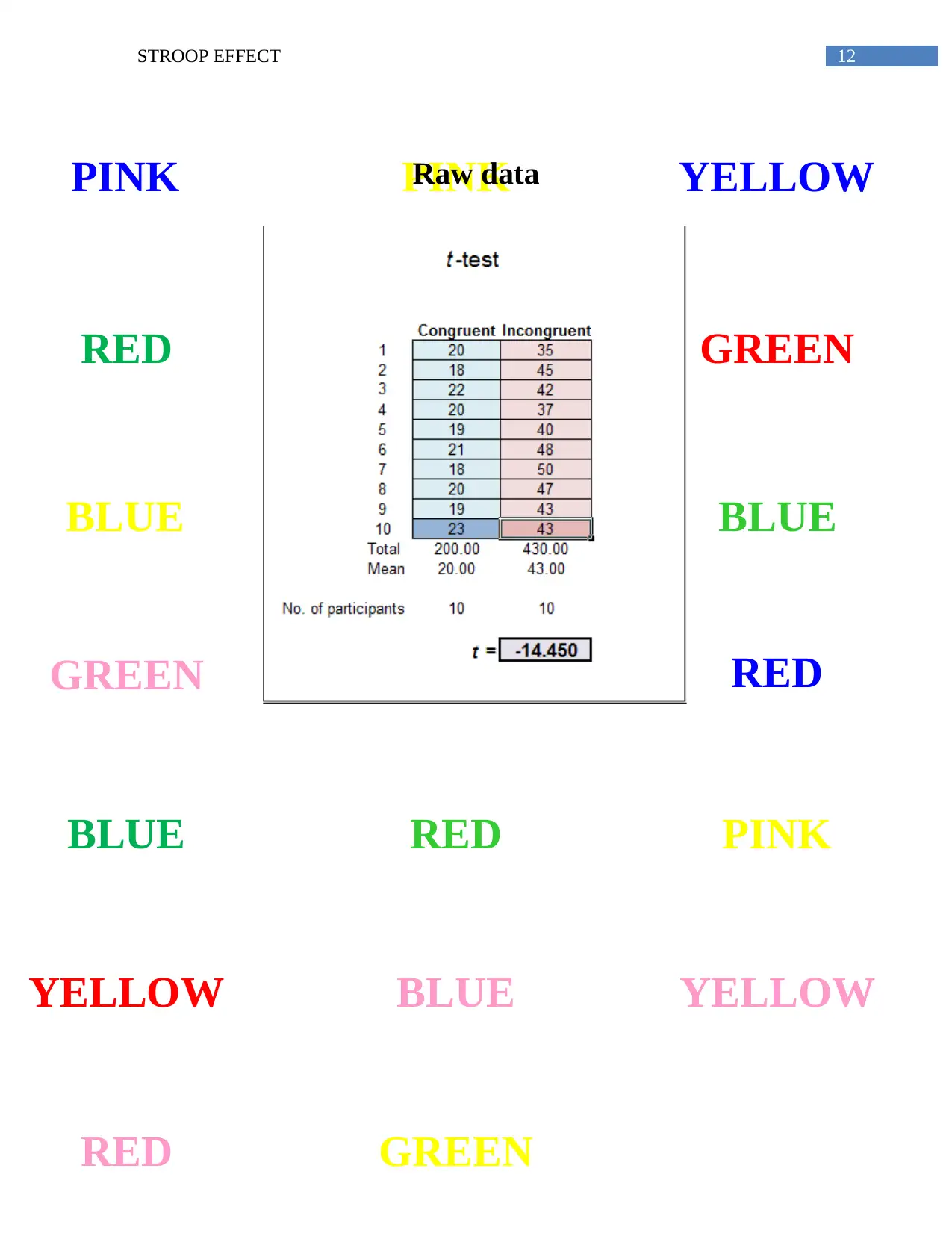
12STROOP EFFECT
PINK
RED
YELLOW
BLUE
GREEN
PINK
RED
GREEN
PINK
RED
YELLOW
BLUE
YELLOW
GREEN
YELLOW
RED
BLUE
GREEN
PINK
BLUE
Raw data
PINK
RED
YELLOW
BLUE
GREEN
PINK
RED
GREEN
PINK
RED
YELLOW
BLUE
YELLOW
GREEN
YELLOW
RED
BLUE
GREEN
PINK
BLUE
Raw data
⊘ This is a preview!⊘
Do you want full access?
Subscribe today to unlock all pages.

Trusted by 1+ million students worldwide
1 out of 12
Related Documents
Your All-in-One AI-Powered Toolkit for Academic Success.
+13062052269
info@desklib.com
Available 24*7 on WhatsApp / Email
![[object Object]](/_next/static/media/star-bottom.7253800d.svg)
Unlock your academic potential
Copyright © 2020–2025 A2Z Services. All Rights Reserved. Developed and managed by ZUCOL.





